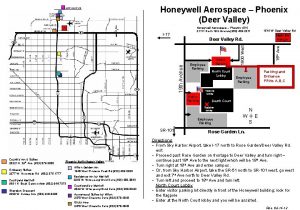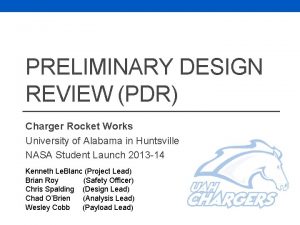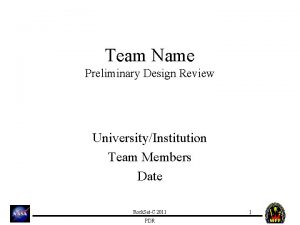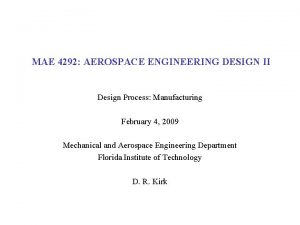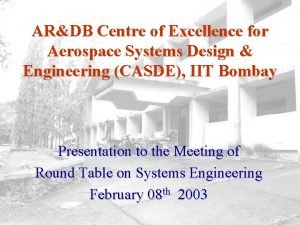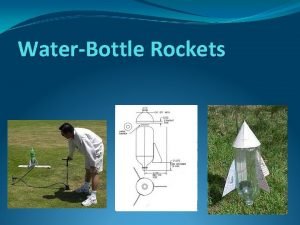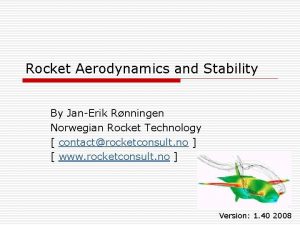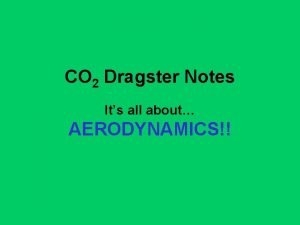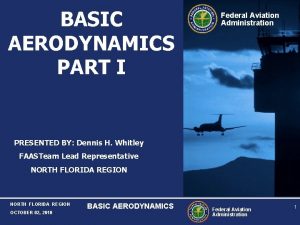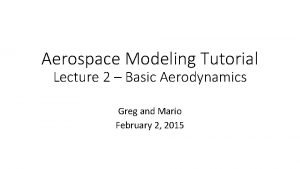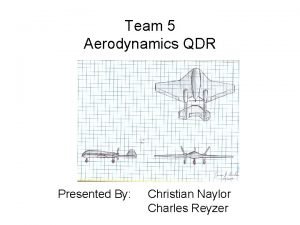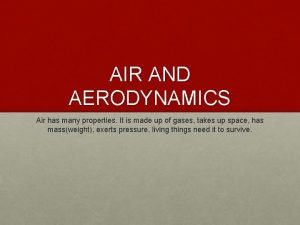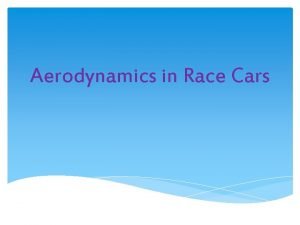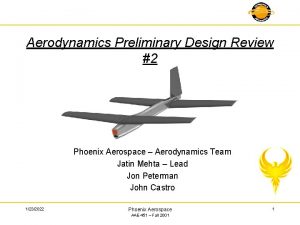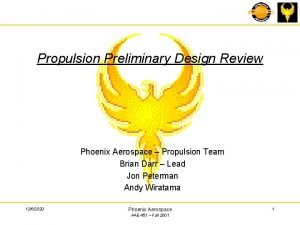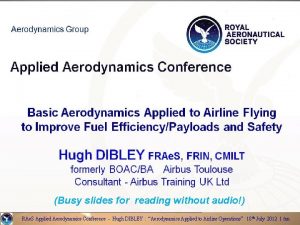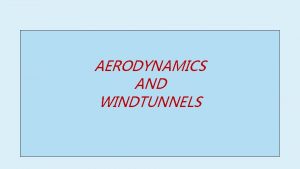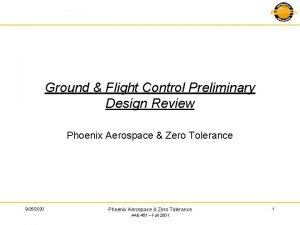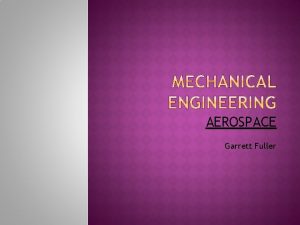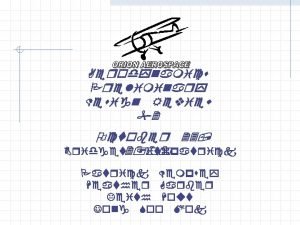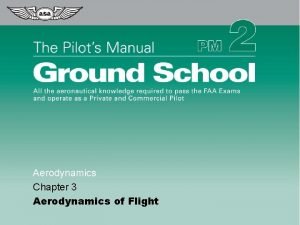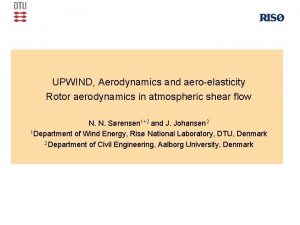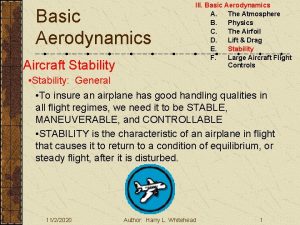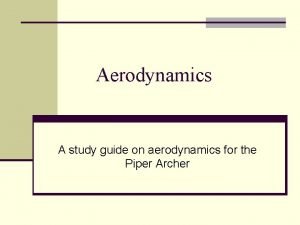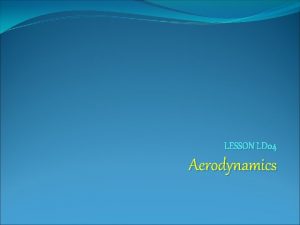Aerodynamics Preliminary Design Review Phoenix Aerospace Aerodynamics Team

















- Slides: 17

Aerodynamics Preliminary Design Review Phoenix Aerospace – Aerodynamics Team Jatin Mehta – Lead John Castro Jon Peterman 2/23/2021 Phoenix Aerospace AAE 451 – Fall 2001 1

Objectives 1. Concept selection & constraint analysis review 2. Preliminary selection of airfoil, geometry, & aircraft layout 1. 2. 3. 4. 5. 6. 7. Airfoil Aspect Ratios Taper Sweep Span Chord Wing & tail location 3. Preliminary aerodynamic analysis 1. Whole Aircraft CL & CD 2. Cruise a & drag estimates 2/23/2021 Phoenix Aerospace AAE 451 – Fall 2001 2

Constraint analysis 1. Constraint analysis review 1. 2. 3. 4. Turn rate constraint is correct Design constrained by turn rate for high turn speeds (Vturn = Vloiter) Design constrained by Ground Roll & Climb rate for lower turn speeds (Vturn = 20 ft/s) Vturn = 25 ft/s for constraint analysis 2/23/2021 Phoenix Aerospace AAE 451 – Fall 2001 3

Constraint Analysis Original Constraint Diagram - Modified Constraint Diagram Modified constraint allows for an increased power loading Smaller propulsion system required to meet requirements (P 30=0. 422 Hp P 25=0. 182 Hp) 2/23/2021 Phoenix Aerospace AAE 451 – Fall 2001 4

Airfoil, Geometry, & Layout Selection Airfoil Selection - 25 Airfoils considered Compared airfoils using: - Clmax, Cla - Drag Polar (design point of W/S=0. 58) - CL= (1/q)(W/S) = 0. 55 ~ Cl - Manufacturing & structural considerations (thickness & trailing edge shape) - Current analysis uses same airfoil for both wings Selig S 1210 airfoil selected - L/Dmax = 74. 5 Clmax = 1. 82 Cdmin = 0. 0138 Max Thickness = 12. 1% Selig S 1210 2/23/2021 Phoenix Aerospace AAE 451 – Fall 2001 5

Airfoil, Geometry, & Layout Selection Cl vs. a Selig S 1210 - Selig S 1210 shows large Clmax advantage over other airfoils studied Cla approximately the same for all airfoils 2/23/2021 Phoenix Aerospace AAE 451 – Fall 2001 6

Airfoil, Geometry, & Layout Selection Cl vs. Cd Selig S 1210 - S 1210 has higher Cdmin However the L/Dmax is the highest of all considered airfoils 2/23/2021 Phoenix Aerospace AAE 451 – Fall 2001 7

Concept, Airfoil, Geometry, & Layout Selection Tandem wing concept chosen - Slight increase in required analysis Concept has good overall characteristics for mission No major problems with concept Added market value due to unique design Geometry Selection - Geometries selected using historical data & trends from Raymer SAE, ICAS, & industry papers on tandem wing & canard configurations used for tandem wing sizing properties Aspect Ratio, AR - Feistel, et al, SAE paper shows that the forward wing should be at a higher aspect ratio than the rear wing to allow the front wing to stall first Aspect ratios chosen from historical data and structural concerns ARFW = 8 ARRW = 7 Detailed analysis of configuration may change AR 2/23/2021 Phoenix Aerospace AAE 451 – Fall 2001 8

Airfoil, Geometry, & Layout Selection Sweep (1/4 chord), L - No sweep is desirable for low speed flight, cruise, and takeoff & landing (Raymer, pg. 61) Taper Ratio, l - Historical data and trends from Raymer used to choose taper ratio Taper ratio required to approximate elliptical lift distribution (Raymer, pg. 64) Wing sweep effects on taper ratio were also taken into account (Raymer, pg. 65) Taper ratio for both wings = 0. 45 Taper ratio may not be used depending on construction technique and material choice Span & Chord, b & c - Span and chord calculated using design area, aspect ratio, and area ratio bwing = (Swing * ARwing)2 cavg, wing = Swing / bwing 2/23/2021 Phoenix Aerospace AAE 451 – Fall 2001 9

Airfoil, Geometry, & Layout Selection Dihedral - Dihedral chosen using estimates in Raymer for high wing (pg. 68) 3 o Dihedral chosen for both wings Wing Separation / Location - Feistel, et al, SAE paper shows that the front and rear wing should be separated vertically and horizontally as much as possible (Vsep ~ 0. 5*cavg Xsep as large as possible) Vsep = 6 in Xsep = 4 ft Vertical Tail Sizing & Location - Tail sized using historical data (previous AAE 451 classes) Will be updated with Stability & Control calculations 2/23/2021 Phoenix Aerospace AAE 451 – Fall 2001 10

Geometry & 3 View 2/23/2021 Phoenix Aerospace AAE 451 – Fall 2001 11

Geometry & 3 View 2/23/2021 Phoenix Aerospace AAE 451 – Fall 2001 12

Geometry & 3 View 2/23/2021 Phoenix Aerospace AAE 451 – Fall 2001 13

Aerodynamic Analysis 2/23/2021 Phoenix Aerospace AAE 451 – Fall 2001 14

Aerodynamic Analysis 2/23/2021 Phoenix Aerospace AAE 451 – Fall 2001 15

Aerodynamic Analysis ******** Front Wing Summary ******** Front Wing Area (ft 2) = 4. 42 Front Wing Span (ft) = 5. 94 Front Wing Average Chord (in) = 8. 91 Front Wing Root Chord (in) = 12. 30 Front Wing Tip Chord (in) = 5. 53 Front Wing Spanwise Efficiency = 0. 89 Front Wing 3 D CLalpha (1/deg) = 0. 0718 --------------------------- ******** Whole Aircraft Summary ******** Whole Aircraft 3 D CLalpha (1/deg) = 0. 1349 Whole Aircraft CLmax. TO = 2. 29 Whole Aircraft 3 D CD = 0. 0380 ********* Rear Wing Summary ********* Rear Wing Area (ft^2) = 4. 42 Rear Wing Span (ft) = 5. 56 Rear Wing Average Chord (in) = 9. 53 Rear Wing Root Chord (in) = 13. 14 Rear Wing Tip Chord (in) = 5. 92 Rear Wing Spanwise Efficiency = 0. 88 Rear Wing Standalone 3 D CLalpha (1/deg) = 0. 0698 Rear Wing Downwash effect = 0. 0956 Rear Wing 3 D CLalpha (1/deg) = 0. 0631 ---------------------------- 2/23/2021 Phoenix Aerospace AAE 451 – Fall 2001 16

Airfoil, Geometry, & Layout Selection - The larger the Cla, the greater the losses due to 3 -Dimensional effects Cla for compared airfoils was constant, thus not a large driver of airfoil selection 2/23/2021 Phoenix Aerospace AAE 451 – Fall 2001 17
 Honeywell aerospace phoenix
Honeywell aerospace phoenix Preliminary design review example
Preliminary design review example Pdr preliminary design review
Pdr preliminary design review Preliminary design review example
Preliminary design review example Preliminary review definition
Preliminary review definition Aerospace design process
Aerospace design process Aerospace systems design and simulation
Aerospace systems design and simulation Water bottle rocket simulator
Water bottle rocket simulator Equation for aerodynamic drag
Equation for aerodynamic drag Dragster aerodynamics
Dragster aerodynamics China aerodynamics research and development center
China aerodynamics research and development center Induced angle of attack
Induced angle of attack Aerodynamics
Aerodynamics Define aerodynamics
Define aerodynamics Lift and drag equation
Lift and drag equation Reyzer 5
Reyzer 5 Air and aerodynamics
Air and aerodynamics Aerodynamics of race cars
Aerodynamics of race cars
